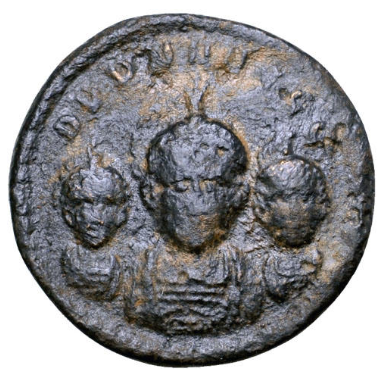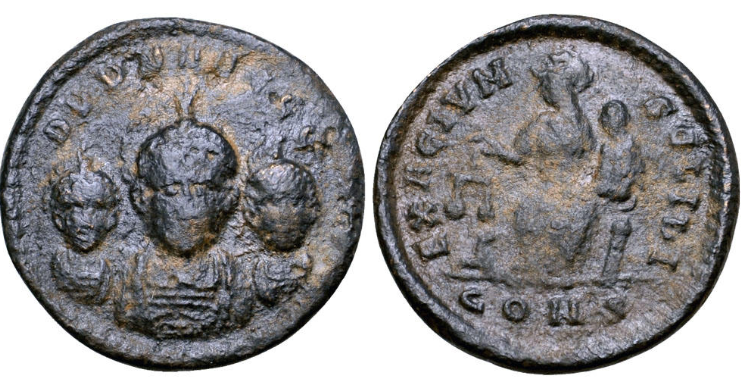
-
Copyright credit: Roma Numismatics Ltd

-
Copyright credit: Roma Numismatics Ltd

-
Copyright credit: Roma Numismatics Ltd

ARCHAEOLOGICAL DESCRIPTION OF THE WEIGHT
Authority
Arcadius, Roman Emperor
;
Honorius, Roman Emperor
;
Theodosius I, Roman Emperor
Mint
Constantinople
Denomination
1 Nomisma = 1 Solidus
Material
Copper alloy (bronze or brass)
Manufacture
Struck
Shape
Disc or similar (ellipse, etc.)
Length
2.10 cm
Width
2.10 cm
Height
- cm
Metrology
| Mass (g) | Mass (grain) | Date of measurement | Reference | fragmented | cleaned | reference weight |
|---|---|---|---|---|---|---|
| 3.83 | - | - | Auction Roma 2018 | No | No | Yes |
Iconography
| Symbol | Technique | Direction | Position | Number | Synecdoche |
|---|---|---|---|---|---|
| Roman Emperor | Stamped / Countermarked / Struck | FACING | Three | Bust | |
| Constantinopolis | Stamped / Countermarked / Struck | LEFT | Seated | One | |
| Nike | Stamped / Countermarked / Struck | LEFT | Standing | One | |
| Globe | Stamped / Countermarked / Struck | One | |||
| Balance scale | Stamped / Countermarked / Struck | One | |||
| Prow | Stamped / Countermarked / Struck | One |
Wear
Corrosion
Handle
No
Suspension hole
No
Recarved mould
No
Recarved weight
No
Intentionally destroyed
No
Archaeological description
Auction Roma 2018: Lot 841. Theodosius I, with Arcadius and Honorius, Æ Exagium Solidi Weight. Constantinople, circa 402-408. DDD NNN GGG, diademed and draped facing imperial busts / EXAGIVM SOLIDI, helmeted Constantinopolis enthroned left with foot on prow, holding scales and Victory on globe; CONS in exergue. Bendall 11; For reverse type cf. RIC X, 88-99. 3.83g, 21mm, 1h. Near Very Fine. Extremely Rare. Official solidus weights, based on a standard 'imperial pound', came into being with the law of Julian of AD 363, which established a zygostates - an official weigher of solidi in each city to restore confidence in the solidus, which had become subject to widespread clipping. Exagium derives from the Latin exigere to drive out - in this case, the underweight solidi, thereby maintaining an acceptable weight standard necessary for the imperial gold coinage to circulate at full value. Many, if not most, such exagia display holes and/or plugs to bring the exagium to the correct weight. Unmodified exagia are thus a rarity.
Asolati 2022: Exagia solidi imperiali con indicazione esplicita della funzione: Teodosio I, Arcadio e Onorio, 393/394–395 d.C., exagium solidi. Zecca di Constantinopolis. D/ DDD NNN GGG; tre busti frontali, affiancati, elmati e corazzati: quello al centro di dimensioni maggiori, quello a d. di dimensioni medie e quello a s. di dimensioni minute. R/ EXAGIVM SOLIDI; Constantinopolis elmata, seduta a s. in trono, il piede d. su una prora di nave, con bilancia nella mano d.; una piccola figura panneggiata siede sulla sponda s. del trono, o su un sostegno, tenendo le gambe appoggiate sulla gamba s. di Constantinopolis; in esergo, CONS. c. Roma, E-Sale 44 (03/03/2018), lotto n. 841: g 3,83; mm 21; h 1.
Asolati 2022: Exagia solidi imperiali con indicazione esplicita della funzione: Teodosio I, Arcadio e Onorio, 393/394–395 d.C., exagium solidi. Zecca di Constantinopolis. D/ DDD NNN GGG; tre busti frontali, affiancati, elmati e corazzati: quello al centro di dimensioni maggiori, quello a d. di dimensioni medie e quello a s. di dimensioni minute. R/ EXAGIVM SOLIDI; Constantinopolis elmata, seduta a s. in trono, il piede d. su una prora di nave, con bilancia nella mano d.; una piccola figura panneggiata siede sulla sponda s. del trono, o su un sostegno, tenendo le gambe appoggiate sulla gamba s. di Constantinopolis; in esergo, CONS. c. Roma, E-Sale 44 (03/03/2018), lotto n. 841: g 3,83; mm 21; h 1.
Autopsy
No
INSCRIPTION
| Language | Technique | Legend type |
|---|---|---|
| Latin | Stamped / Countermarked / Struck | Authority, Denomination, Legal status, Mint |
Fac simile
DDD[NNNGGG]
EXAGIVM SOLIDI
CONS
Edition
D(ominorum) [N(ostrorum) (Au)g(ustorum)]. || Exagium solidi | Cons(tantinopolis).
Monogram
ARCHAEOLOGICAL CONTEXT
Findspot (region)
Findspot (site)
context
CIRCUMSTANCES OF ACQUISITION
Region
City
Date of first acquisition
March 3, 2018
circumstances
Antiquities trade.
DATING OF THE WEIGHT
Curatorial Section
LATE ROMAN AND BYZANTINE
Time frame
FROM
393
TO
408
Comments on Chronology
Asolati 2022: The exagium is dated from 393 to 395 because the joint reign of Honorius, Arcadius and Theodosius I began in 393 and ended in 395.
Auction Roma 2018: Datation between 402 and 408 but the same emperors are identified.
Auction Roma 2018: Datation between 402 and 408 but the same emperors are identified.
COLLECTION HISTORY
Collection
| Name | Date of acquisition | Inventory number |
|---|---|---|
| Antiquities Trade | March 3, 2018 | None |
Bibliography
| Reference | Page/Column | Reference (number) | Plate / Figure | Comment |
|---|---|---|---|---|
| Auction Roma 2018b | None | 841 | fig. | None |
| Asolati 2022 | 255–256, 270 | 3c | Pl. I/3c | None |
VARIA
Additional comment
Asolati 2022: cf. RIC X, p. 8; Bendall 1996, n. 11; Entwistle 2001, p. 264, n. III.69.
Permalink
External link